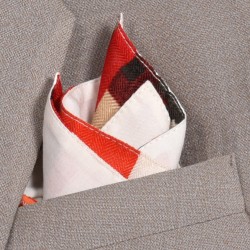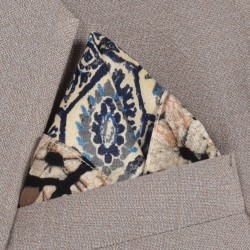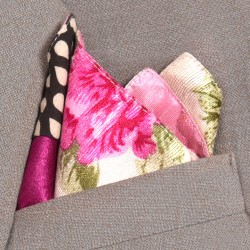The pocket square, peeking from the breast pocket of a well-cut suit, has become the defining style element in every gentleman's wardrobe. So how did the little piece of cloth gain such prominence in fashion?

It all started way back in ancient Greece, as early as 500 B.C., when wealthy greeks carried around perfumed hankies to protect themselves from the odors of the street. The true ancestor of the pocket square though, is the handkerchief. Around the 1400s the use of the handkerchief became popular for practical uses and as an accessory.The English King Richard II was known to carry a handkerchief "as a little piece of cloth for the lord King to wide and clean his nose." Handkerchiefs were made of exotic materials like silk and were embroidered with beautiful patterns to show one's wealth and status. In the 16th century, Catherine De Medici of Florence imported the best embroidery and laced kerchiefs from Italy into France. The quality and design of lace being used determined its value and such valuable accessories were passed down to generations. Queen Mary and Queen Elizabeth were known to receive handkerchiefs as presents at New Years.
The handkerchief was carried around by men for centuries in their trouser pocket. It is only in the early 20 century, when men became more conscious of hygiene and decided that the handkerchief should not mingle in the pockets with dirty objects like coins and the like. The handkerchief then moved to the clean, less used, breast pocket of the two piece suit which had come into fashion in the early 19th century. Hollywood stars James Cagney and Fred Astaire helped to popularise the pocket square as a fashion accessory in the '60s. And the rest, as they say, is history.
Here are some tips to wear a pocket square. Contrary to popular belief, a pocket square should not match your tie. The colour of your pocket square should complement your shirt, tie or jacket being of the same tone or colour. Navy suits can be warmed up with pocket squares in red or burgundy while grey suits work well with lighter shades of blue. The colour and pattern of pocket square you choose should reflect your personal style. The art of folding a pocket square allows for a variety of looks and dimensions. It is important to remember though that simple folds work better with cotton and linen pocket squares whereas more complex folds suit silk pocket squares best.
The Presidential or classic fold is the simple square fold with only one inch of the square visible from the pocket. As the name suggests, this fold should be reserved for business or formal functions where dignity and formality is observed and appreciated.
The One-point or two point fold, leaves a triangular one peak or two peak section of the pocket square displayed from the pocket. This is a more stylish look for the pocket square and suits a silk or woollen material the best. Another style trick to tone down your look is to skip wearing a tie completely and wear a brightly coloured pocket square with your suit instead.
And finally, the unstructured fold creates the most elegantly casual look for a gentleman. There are innumerable ways to fold a pocket square. Find one that matches your mood and the occasion and enjoy the attention that follows!
Pocket squares at Natsy by Design come in an array of different patterns and materials - from silk to cotton, from hand block printed to checkered, in colours to suit every occasion and season. This season let the pocket square do the talking as you dress up for the seasonal and year end celebrations. Gift yourself or a deserving gentleman, a fashionable pocket square or two.







-150x150w.jpg)



Leave a Comment